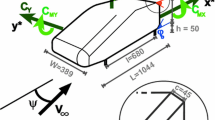Abstract
A large contribution to the aerodynamic drag of a vehicle arises from the failure to fully recover pressure in the wake region, especially on squareback configurations. A degree of base pressure recovery can be achieved through careful shape optimisation, but the freedom of an automotive aerodynamicist to implement significant shape changes is limited by a variety of additional factors such styling, ergonomics and loading capacity. Active flow control technologies present the potential to create flow field modifications without the need for external shape changes and have received much attention in previous years within the aeronautical industry and, more recently, within the automotive industry. In this work the influence of steady blowing applied at a variety of angles on the roof trailing edge of a simplified ¼ scale squareback style vehicle has been investigated. Hot-wire anemometry, force balance measurements, surface pressure measurements and PIV have been used to investigate the effects of the steady blowing on the vehicle wake structures and the resulting body forces. The energy consumption of the steady jet is calculated and is used to deduce an aerodynamic drag power change. Results show that overall gains can be achieved; however, the large mass flow rate required restricts the applicability of the technique to road vehicles. Means by which the mass flow rate requirements of the jet may be reduced are discussed and suggestions for further work put forward.














Similar content being viewed by others
Abbreviations
- C d :
-
Aerodynamic drag coefficient
- C μ :
-
Momentum coefficient
- l :
-
Measured length (mm)
- w :
-
Measured width (mm)
- h :
-
Measured height (mm)
- L :
-
Model length (mm)
- W :
-
Model width (mm)
- H :
-
Model height (mm)
- l/L :
-
Non-dimensional length
- w/W :
-
Non-dimensional width
- h/H :
-
Non-dimensional ride height
- m j :
-
Mass flow rate exiting jet (kg/s)
- V j :
-
Mean jet exit velocity (m/s)
- Q :
-
Freestream dynamic pressure (Pa)
- A :
-
Model frontal area (m2)
- E :
-
Ratio of model frontal area to wind tunnel cross-sectional area
- Δt :
-
PIV inter-frame time
- L :
-
Model length (m)
- R e :
-
Reynolds number
- C p :
-
Coefficient of pressure
- \( \bar{C}_{p} \) :
-
Area-weighted pressure coefficient
- l/L :
-
Non dimensional length
- APNET :
-
Net change in aerodynamic power (Watts)
- ΔF D :
-
Change in drag force (N)
- V :
-
Freestream velocity (m/s)
- η j :
-
Blowing system efficiency
References
Bearman P, Morel T (1983) Effect of freestream turbulence on flow around bluff bodies. Prog Aerosp Sci 20:97–123. doi:10.1016/0376-0421(83)90002-7
Brunn A, Nitsche W (2006) Active control of turbulent separated flows over slanted surfaces. Int J Heat Fluid Flow 27:748–755. doi:10.1016/j.ijheatfluidflow.2006.03.006
Englar R (2003) Drag reduction, safety enhancement and performance improvement for heavy vehicles and SUVs using advanced pneumatic aerodynamic technology. SAE International Paper No. 2003-01-3378 doi:10.4271/2003-01-3378
Geropp D, Odenthal H-J (2000) Drag reduction of motor vehicles by active flow control using the coanda effect. Exp Fluids 28(1):74–85. doi:10.1007/s003480050010
Glezer A, Amitay M (2002) Synthetic jets. Annu Rev Fluid Mech 34:503–529. doi:10.1146/annurev.fluid.34.090501.094913
Hollis D (2004) Particle image velocimetry in gas turbine combustor flow fields. PhD Thesis, Loughborough University
Horn H, Neubeck J, Wiedemann J (2011) Rating mass-related energy demand for vehicles with new powertrain concepts. SAE International Paper No. 2011-37-0010 doi:10.4271/2011-37-0010
Hucho W (1998) Aerodynamics of road vehicles. Society of Automotive Engineers, P38
Lin J, Towfighi J, Rockwell D (1999) Near wake of a circular cylinder: control by steady and unsteady surface injection. J Fluids Struct 9(6):659–669. doi:10.1006/jfls.1995.1036
Littlewood R, Passmore M (2010) The optimization of roof trailing edge geometry of a simple squareback. SAE International Paper No. 2010-01-0510 doi:10.4271/2010-01-0510
Littlewood R, Passmore M, Wood D (2011) An investigation into the wake structure of square back vehicles and the effect of structure modification on resultant vehicle forces. SAE International Paper No. 2011-37-0015 doi:10.4271/2011-37-0015
Pastoor M, Henning L, Noack B, King R, Tadmor G (2008) Feedback shear layer control for bluff body drag reduction. J Fluid Mech 608:161–196. doi:10.1017/S0022112008002073
Ribaldone E (2010) Application of multi-objective optimization to the aerodynamic development of passenger vehicles at FIAT. 8th MIRA International Vehicle Aerodynamics Conference 2010
Rouméas M, Gilliéron P, Azeddine K (2008) Analyze and control of the near wake flow over a squareback geometry. Comput Fluids 38:60–70. doi:10.1016/j.compfluid.2008.01.009
Schrefl M (2010) The audi A1—aerodynamics and aeroacoustics. 8th MIRA International Vehicle Aerodynamics Conference 2010
Schultz S (2010) Aerodynamics of modern sport utility vehicles. 8th MIRA International Vehicle Aerodynamics Conference 2010
Sovran G (1983) Tractive energy based formulae for the impact of aerodynamics on fuel economy over the EPA driving schedules. SAE International Paper No. 830304 doi:10.4271/830304
Acknowledgments
The authors would like to thank Rob Hunter and Stacey Prentice with all their help in preparing the models for the tests carried out in this paper.
Author information
Authors and Affiliations
Corresponding author
Rights and permissions
About this article
Cite this article
Littlewood, R.P., Passmore, M.A. Aerodynamic drag reduction of a simplified squareback vehicle using steady blowing. Exp Fluids 53, 519–529 (2012). https://doi.org/10.1007/s00348-012-1306-4
Received:
Revised:
Accepted:
Published:
Issue Date:
DOI: https://doi.org/10.1007/s00348-012-1306-4




